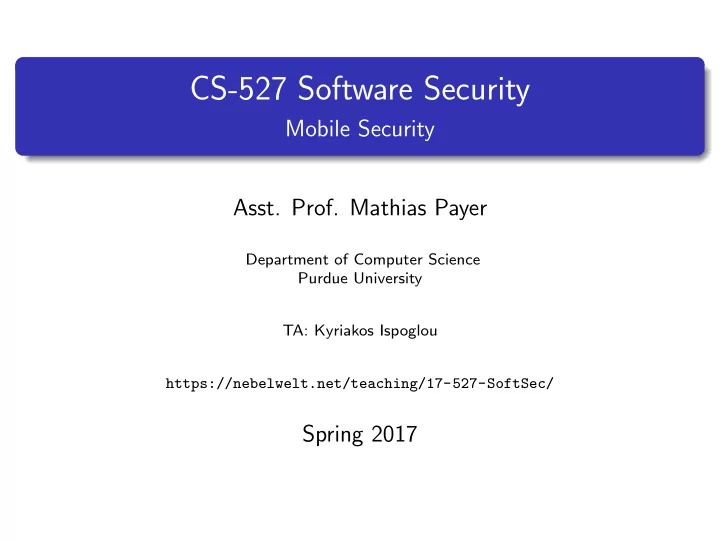

CS-527 Software Security Mobile Security Asst. Prof. Mathias Payer Department of Computer Science Purdue University TA: Kyriakos Ispoglou https://nebelwelt.net/teaching/17-527-SoftSec/ Spring 2017
Android Security Table of Contents Android Security 1 Summary and conclusion 2 Mathias Payer (Purdue University) CS-527 Software Security 2017 2 / 15
Android Security Android statistics 1.4 billion users (DMR stats, 9/29/15) Android generates $31 billion revenue (Bloomberg, 1/21/16) 4,000+ different devices (DMR stats, 9/29/15) Android OS with highest crash rate: Gingerbread (Greenbot, 3/27/14) Percentage of Android devices running Marshmallow: 1.2% (DMR stats, 2/2/16) Percentage of Android devices running Lollipop: 34.1% (DMR stats, 2/2/16) Mathias Payer (Purdue University) CS-527 Software Security 2017 3 / 15
Android Security Android history 2005: Google buys Android 2007: Initial SDK released 2008: First devices announced 2009: Cupcake (1.5, 3), Donut (1.6, 4), Eclair (2.0, 5) 2010: Froyo (2.2, 8), Gingerbread (2.3, 9) 2011: Honeycomb (3.0, 11), Ice Cream Sandwich (4.0.1, 14) 2012: Jelly Been (4.1.1, 16) 2013: KitKat (4.4, 19) 2014: Lollipop (5.0, 21) 2015: Marshmallow (6.0, 23) 2016: Nougat (7.0, 24-25) 2017: ? Mathias Payer (Purdue University) CS-527 Software Security 2017 4 / 15
Android Security Android security goals Isolate individual applications Protect system resources from applications Vet applications “online” Protect data of the user (until 5.0 single user) Mathias Payer (Purdue University) CS-527 Software Security 2017 5 / 15
Android Security Android security architecture Architecture The security of Android devices depends on a three tiered architecture: (i) applications are carefully vetted server-side and only approved applications can be installed from the “market”, (ii) each application runs in a Java-like sandbox and is restricted to user-granted permissions and can therefore only communicate through well-defined API channels with other applications, and (iii) the system is hardened against local user (app-based) attacks. Mathias Payer (Purdue University) CS-527 Software Security 2017 6 / 15
Android Security Android security fundamentals Each apps runs in its own secure context/sandbox Interactions between apps are restricted through the API Each app has an associated policy, encoding the permissions Apps are signed by the developer, vetted, and installed from a central market. Mathias Payer (Purdue University) CS-527 Software Security 2017 7 / 15
Android Security Android kernel security Hardened Linux kernel protects applications Each application runs as its independent user Stringent permissions on file systems (except sdcard) SELinux to apply access control policies on processes File system encryption (since 3.0) Mathias Payer (Purdue University) CS-527 Software Security 2017 8 / 15
Android Security Android user-space security for memory safety Stack canaries, integer overflow protection, double free protection (through allocator), and calloc instead of malloc (1.5) Format string protection, NX, and mmap min addr (2.3) ASLR (4.0), PIE, read only relocations, immediate binding, avoid kernel address leaks (4.1) fortify source, init script hardening, certificate pinning (4.2) SELinux, no suid, ADB authentication, capability bounding, more fortification (4.3) Stronger SELinux, stronger fortification (4.4) More SELinux/fortification, everything PIE, disk encryption (5.0) Verified boot, hardware security, system hardening (6.0) More service hardening, better updates (7.0) Each release: security updates, patches, and toolchain updates Mathias Payer (Purdue University) CS-527 Software Security 2017 9 / 15
Android Security Android permissions Android has many types of complex permissions. Camera functions Location data (GPS) Bluetooth functions Telephony functions SMS/MMS functionality Network/data connections Mathias Payer (Purdue University) CS-527 Software Security 2017 10 / 15
Android Security Android intents Intent An Intent is a simple message object that represents an “intention” to do something. For example, if your application wants to display a web page, it expresses its “Intent” to view the URL by creating an Intent instance and handing it off to the system. The system locates some other piece of code (in this case, the Browser) that knows how to handle that Intent, and runs it. Intents can also be used to broadcast interesting events (such as a notification) system-wide. a a This is Google’s definition of an intent. Mathias Payer (Purdue University) CS-527 Software Security 2017 11 / 15
Android Security Android attack vectors Unauthorized intent receipt: attacker creates an intent filter and receives intents from other apps that contain privileged information (e.g., intent filter for web service that intercepts online payment process) Intent spoofing: attacker sends a malicious intent to an intent processor (e.g., flooding the network with malicious messages) Insecure storage: there are no access restrictions on the SD card (why?), an attacker may read/write any data on the SD card Insecure communication: an attacker may run wireshark to intercept traffic Overprivileged app: a bug in an app allows an attacker to leverage these privileges. Mathias Payer (Purdue University) CS-527 Software Security 2017 12 / 15
Summary and conclusion Table of Contents Android Security 1 Summary and conclusion 2 Mathias Payer (Purdue University) CS-527 Software Security 2017 13 / 15
Summary and conclusion Summary Android security evolved over time Android systems are hardened against exploits Developers sign their app and required permissions Applications are vetted centrally and installed from the market Mathias Payer (Purdue University) CS-527 Software Security 2017 14 / 15
Summary and conclusion Questions? ? Mathias Payer (Purdue University) CS-527 Software Security 2017 15 / 15
Recommend
More recommend